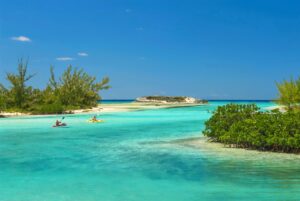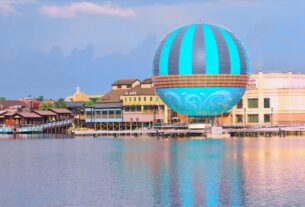When most people hear “The Bahamas,” they envision turquoise waters, powdery white sand, and endless sunshine—and they’re right. But beyond the postcard-perfect beaches lies a destination rich in history, culture, marine life, and vibrant island communities. Comprising over 700 islands and 2,400 cays, The Bahamas is a treasure trove of tropical adventure and serene escape.
🌴 Get Your FREE Bahamas Checklist!
Perfect for planning your island escape 🌊
We respect your privacy. Unsubscribe anytime.
Powered by greattravelnews.com
In this guide, we explore the best places to visit in The Bahamas—from famous beach resorts to hidden island gems—so you can create the perfect tropical itinerary, whether you’re planning a luxury vacation, romantic honeymoon, or laid-back island hop.
🇧🇸 Why Visit The Bahamas?
- 🌞 Year-round warm weather (especially ideal from November to May)
- 🌊 Crystal-clear waters for snorkeling, diving, and boating
- 🐠 Rich marine biodiversity and world-class coral reefs
- 🏖️ Gorgeous beaches and private islands
- ✈️ Easy access from the U.S., Canada, and Europe
1. Nassau – Capital of Culture and Convenience
Nassau, the capital of The Bahamas located on New Providence Island, is often the first stop for travelers. It’s a bustling hub that mixes colonial charm, Bahamian culture, and modern resort life.
Top Things to Do in Nassau:
- Explore the historic Queen’s Staircase and Fort Fincastle
- Visit the Pirates of Nassau Museum
- Relax at Cable Beach or Junkanoo Beach
- Stroll the Straw Market for local crafts
- Take a day trip to Blue Lagoon Island
Best For: First-timers, cruise travelers, culture lovers
Where to Stay: Atlantis Paradise Island, Baha Mar Resort, boutique guesthouses
2. Paradise Island – Luxury and Adventure Combined

Connected to Nassau by a short bridge, Paradise Island is known for its opulent resorts, aquariums, and thrilling waterparks. It’s home to the iconic Atlantis Resort, which is a destination in itself.
Top Things to Do on Paradise Island:
- Visit Aquaventure Water Park at Atlantis
- Snorkel in The Dig (marine habitat)
- Try your luck at the Atlantis Casino
- Relax on Cabbage Beach
Best For: Families, couples, resort lovers
Pro Tip: Even if you’re not staying at Atlantis, day passes are available.
3. Exuma Cays – Swim with Pigs & Find Secluded Bliss
Exuma is a group of 365 cays, many of which are uninhabited. The clear, shallow waters here are ideal for boating and snorkeling, and it’s also home to one of The Bahamas’ most Instagrammed experiences—swimming with pigs on Big Major Cay (a.k.a. Pig Beach).
Top Things to Do in the Exumas:
- Swim with pigs at Big Major Cay
- Explore Thunderball Grotto (James Bond film site)
- Feed iguanas on Allen’s Cay
- Dive into Dean’s Blue Hole (one of the world’s deepest)
- Relax on Tropic of Cancer Beach
Best For: Adventure seekers, honeymooners, wildlife lovers
Getting There: Fly into George Town, Exuma, or take a boat from Nassau
4. Harbour Island – Chic and Charming Pink Sands
Harbour Island is known for its pastel-painted cottages, golf cart transportation, and the iconic Pink Sands Beach. It’s both upscale and laid-back, offering a quiet escape with excellent dining and boutique hotels.
Top Things to Do on Harbour Island:
- Walk or ride a horse on Pink Sands Beach
- Explore Dunmore Town’s colonial charm
- Try conch salad at Queen Conch
- Go deep-sea fishing or scuba diving
Best For: Couples, boutique travelers, beach photography
Fun Fact: The pink sand gets its hue from crushed coral and foraminifera.
5. Andros Island – Nature, Blue Holes, and Local Culture
Andros is the largest island in The Bahamas, but also one of the most unexplored. It’s a paradise for divers, birdwatchers, and eco-tourists, offering a chance to experience untouched Bahamian beauty.
Top Things to Do in Andros:
- Dive the world’s third-largest barrier reef
- Swim in Blue Holes National Park
- Fish for bonefish in the flats
- Visit local settlements like Fresh Creek and Red Bays
Best For: Nature lovers, adventurers, off-the-grid travelers
Getting There: Small flights from Nassau or ferry service
6. Eleuthera – The Skinny Island of Secret Beaches
Eleuthera stretches over 100 miles and is famous for its pineapple plantations, pink sand beaches, and dramatic cliffs. It offers a more local, authentic Bahamian experience with fewer tourists.
Top Things to Do in Eleuthera:
- Visit the Glass Window Bridge (Atlantic meets Caribbean)
- Snorkel around Current Cut
- Explore Hatchet Bay Cave
- Chill on French Leave Beach
Best For: Road trippers, photographers, independent travelers
Combine With: Harbour Island via water taxi from North Eleuthera
7. The Abacos – Sailing, Cays, and Caribbean Calm
The Abaco Islands are a group of islands and cays in the northern Bahamas, known for boating, sailing, and quiet island life. After rebuilding from Hurricane Dorian, the region is welcoming tourists once again with resilient spirit.
Top Things to Do in the Abacos:
- Sail between Elbow Cay, Man-O-War Cay, and Green Turtle Cay
- Climb the Hope Town Lighthouse
- Snorkel in Mermaid Reef
- Fish in the Abaco Marls
Best For: Boaters, sailors, quiet vacationers
Travel Tip: Fly into Marsh Harbour or Treasure Cay
8. Bimini – Hemingway’s Favorite Fishing Spot
Just 50 miles from Miami, Bimini is the closest Bahamian island to the U.S. It’s famous for sport fishing, wreck diving, and a laid-back island vibe that once inspired Ernest Hemingway.
Top Things to Do in Bimini:
- Swim with wild dolphins
- Dive the SS Sapona shipwreck
- Explore the Bimini Road (mythical Atlantis connection)
- Visit the Bimini Shark Lab
Best For: Weekend getaways, divers, anglers
Getting There: Ferry from Miami or 30-minute flight
9. Cat Island – Mystical Mountains and Quiet Shores

Cat Island is one of the least developed islands, perfect for those seeking solitude and natural beauty. It’s home to Mount Alvernia, the highest point in The Bahamas, and The Hermitage monastery at its summit.
Top Things to Do on Cat Island:
- Hike to The Hermitage
- Swim in Mermaid Hole
- Discover ruins of cotton plantations
- Enjoy the beaches with barely a soul around
Best For: Spiritual retreats, writers, solitude seekers
10. Long Island – Cliff Diving and Hidden Beaches
Long Island offers dramatic contrasts, with rocky cliffs on the east and serene beaches on the west. It’s also the location of Dean’s Blue Hole, the second-deepest known saltwater blue hole in the world.
Top Things to Do in Long Island:
- Cliff dive or snorkel at Dean’s Blue Hole
- Explore Hamilton Caves
- Relax on Cape Santa Maria Beach
- Take a boat to Sandy Cay
Best For: Divers, road-trippers, off-the-beaten-path explorers
🌺 Tips for Traveling in The Bahamas
- Currency: Bahamian Dollar (BSD), equal to USD
- Language: English
- Best Time to Visit: December to April (less rain, lower humidity)
- Travel Between Islands: Domestic flights, ferries, or private boats
- Entry Requirements: Valid passport (check for visa rules based on your country)
🏝️ Final Thoughts: Which Island Should You Choose?
The Bahamas offers something for every kind of traveler. Whether you’re looking for luxury resorts, adventure diving, quiet beaches, or rich cultural experiences, you’ll find it here. For first-timers, Nassau and Paradise Island are a great intro. For those craving seclusion and nature, islands like Andros, Cat Island, or Long Island are unbeatable. And for Instagram-worthy moments and animal encounters, don’t skip the Exumas.
Plan smart, explore freely, and let the islands guide your next adventure. 🌞
Safe travels and see you on the sand!
Written by: greattravelnews.com – Your Source for Global Island Escapes




